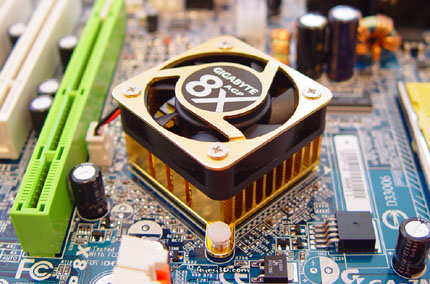Page 4 - BIOS & Overclocking features
BIOS & overclockingTweaking can be done at BIOS level. I must state that Gigabyte managed to do an okay job here, the results where not amazing but that was a limitation of our Athlon XP 1800+ CPU which we got stable up-to a 2000+ rating (as we can do with any other mainboard).
What's nice is the option to go (2x)300MHz with your FSB, which is more than enough for the most daring overclockers out there. AMD will not go higher than (2x)200 MHz as the 32-bit Athlon is slowly coming closer to the end of it's life-cycle.
With the following settings however you'll achieve a reasonable overclock. Changeable settings are:
-
CPU Voltage up to 1.850V in 0.0250V increments
-
CPU Host Frequency (FSB) up to 300 MHz
-
CPU:AGP clock locked at default frequencies (66MHz/33MHz) regardless of the FSB
-
Fixed PCI/AGP Frequency
-
DDR:CPU Ratio (2.00x, 2.50x and auto)
-
AGP port voltage (0.1V increments up to 1.8V)
-
DDR Voltage (available up to 2.8V in 0.1V increments)
One additional feature in the BIOS we'd like to mention is chipset voltage adjustments. The 7NNXP BIOS will allow you to adjustment chipset voltage of 5%, 7.5%, and 10%.
Furthermore in the BIOS you'll find the standards like System and CPU temperatures, CPU, System, and Power fan speeds, Vcore, VDIMM, and PSU readings and a CPU Smart Fan Control which regulates the speed of your CPU HSF depending on the temperature of your CPU.
Here's a small trick, if you want to tweak your memory then in the BIOS press CTRL + F1. This will show tweaking options within the Advanced Chipset Features section and includes a plethora of memory timing options, such as CAS Latency, RAS to CAS Delay, RAS Precharge, and Precharge Delay.
There are other performance related features as FSB frequency, AGP frequency, memory frequency, the notorious AGP fast write option and of course the CPU interface option (Aggressive, Turbo, Expert or Optimal available). If you are a novice, then please do not use the CTRL+F1 function as you can seriously mess up your system stability.

Luckily that Northbridge has very good cooling, you'll need it if you increase chipset voltage
